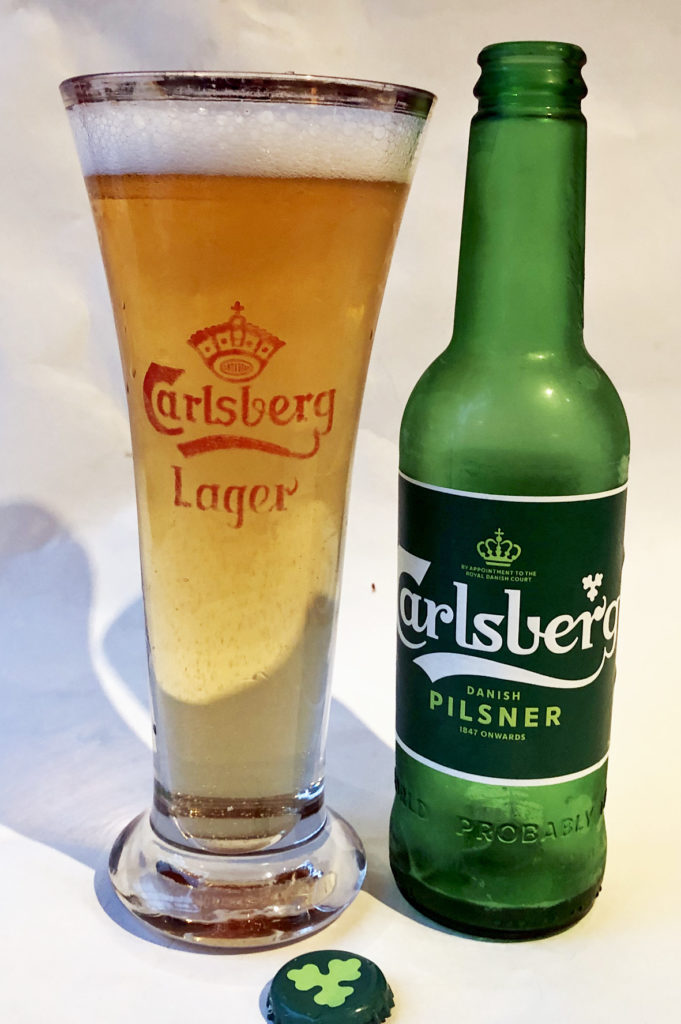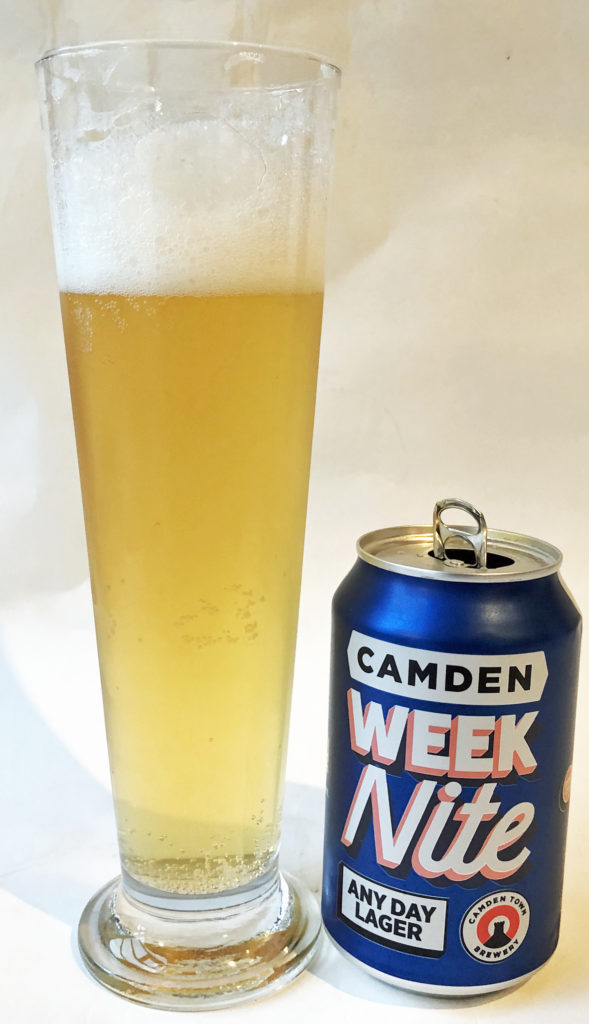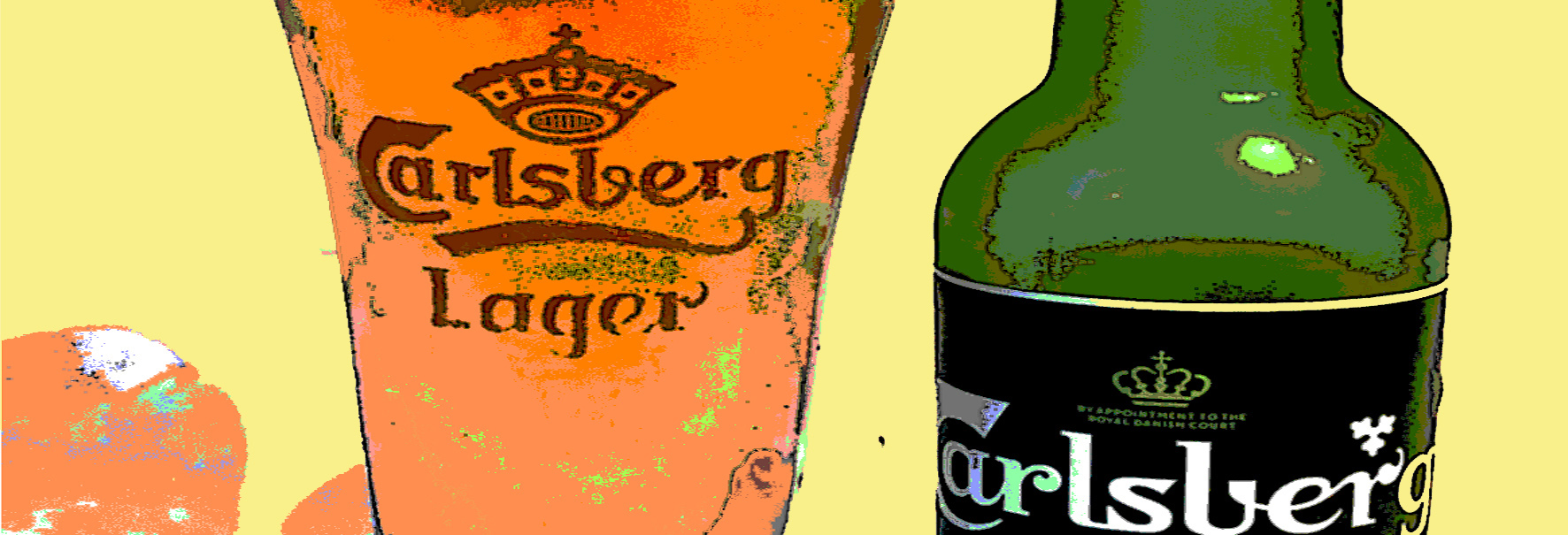A few years back, when I was still involved in hospitality trade journalism, I would get occasional invites from Carlsberg to PR gigs. One was to Wembley to see England play San Marino. The match itself was the predictable turkey-stuffing (5-0) but it was the entertainment beforehand we were particularly supposed to appreciate: Northampton’s Danes had taken over part of Wembley town hall and turned it into an “If Carlsberg did pubs” pub, with unlimited free pints of lager delivered on sushi-style conveyor belts, the Lightning Seeds as the pub band and Ian Wright, Paddy McGuinness and Jeff Stelling as pre-match pundits. It was quite fun, as quite fun goes, but the big drawback was the beer: Carlsberg.

I don’t have anything against big-corporation beer in itself, but I do have a big problem with dull beer: I can’t drink it. I have a very low boredom threshold with food and drink (and most other experiences, actually) and I would literally rather drink nothing than drink more than a couple of pints of beer with no interest. And that Carlsberg: it wasn’t actually bad, or faulty, it was simply a cypher, a blank hole where beer should have been. There was no pain in drinking it, but it was a hedonistic vacuum that actively repelled me, that made me not wish to experience this beery nothing.
The one upside, I thought, was that at least I wasn’t going to get embarrassingly drunk on free beer, since I couldn’t bring myself to bring it near my mouth. So I waited, faintly bored, until the drinking was over and we could go and watch the match – which was a similar sort of experience to the beer, ironically. Had it been a ten-nil walloping, that would have been good to watch. Had it been decent opposition, that would have been good, too. But five-nil against San Marino, a country with a population the size of Letchworth: meh.
So: come forward to the present day, and the Cobblertown-based Danes are now apparently admitting that, indeed, their beer really hasn’t been up to much: the San Marino of beerdom. In the run-up to a relaunch last month of the basic 3.8 per cent abv “Green” Carlsberg, the company started retweeting tweets from drinkers comparing the beer to drinking stale breadsticks, or the bathwater your granny died in, using the increasingly popular “beat us, we’re bad” strategy marketeers seem to think makes consumers love them because they’re apparently being deeply honest, for a change. Then its VP of marketing in the UK, Liam Newton, pulled on the sackcloth, dumped a pile of ashes over his head, threw himself on his knees and wailed: “At Carlsberg UK, we lost our way. We focused on brewing quantity, not quality; we became one of the cheapest, not the best. In order to live up to our promise of being ‘probably the best beer in the world’, we had to start again.” Actually, Liam, you used to say “Probably the best lager in the world”, you little fibber, not least because prosodically the two beats of “lager” make for a better-sounding slogan that the single beat of beer: cretic, trochee, spondee, cretic rather than the clunkier cretic, cretic, cretic,
Green Carlsberg is now calling itself a Danish pilsner, rather than a lager: presumably “consumer feedback” suggests “pilsner” sounds posher. Poor Bhavya Mandanna, head brewperson at Carlsberg UK, ventriloquised the following nonsense, courtesy of Carlsberg’s PR people: “Our new Pilsner has a fuller body and a perfect balance of bitterness and sweetness made possible through modifications to our brewing process and the addition of bittering hops in the brewhouse.” Wow, they’re adding bittering hops in the brewhouse! There’s innovative! Tell us more, Bhavya, and let’s see if you can say it while the PR man sits you in his knee with his hand up the back of your jacket as he swallows a pint of supposedly perfectly balanced lager: “Aroma hops with citrus and floral top notes give a greater depth of flavour whilst maintaining the light and refreshing qualities of Carlsberg.”
Enough guff. Just because PR people make it appear you’re as filled with marketing bollocks as they are, it doesn’t mean you’re automatically a bad brewer. It’s only fair to put Bhavya’s new-style Green Carlsberg in a taste-off to see how it performs. I decided to pair it against Camden Town’s new “Weeknite Any Day” lager, a 3 per cent beer I suspect only escaped being called “Everyday lager” because that would have given the Portman Group the blue giptions for suggesting you could drink every day. And the result is (the envelope, please …)
The result, I’m actually disappointed to say, is exactly what a cynic might expect. The “new” Green Carlsberg, selling for £1 a 33cl bottle in your local corner offie (that’s £1.72 a pint), is scarcely less dull than its previous incarnation. It smells of almost nothing. It tastes of almost nothing. There’s a faintly meaty, metallic aftertaste that lingers for too long. More flavour comes through as the beer opens up in the glass, but so does a bitterness just hovering on the edge of unpleasant. A slight malt sweetness is present, but the main sensation is of something massively watered down. I’m bored even thinking about it.This is NOT the future of beer, and Carlsberg are only wasting time on what should be a controlled rundown of a beer in terminal decline.

Camden Town’s Week Nite, though, is a little bit of a revelation. It’s one of a growing number of what might be called “floral” or “fruity” lagers, cold-fermented beers made with hop varieties more normally associated with warm-fermented American IPAs: Galaxy, a strongly flavoured Australian hop with lots of tropical fruit/peach aromas, Topaz, another Australian hop, with hints of clove and lychee and Mosaic, from the US, with more tropical/floral/citrus flavours – that are becoming increasingly popular – see, for example, Guinness’s Hop House 13, very likely to be already on a bar top near you just three years after its launch.
What this new style of lager is delivering is taste, something that, 20 years after the American IPA revolution, is finally becoming a mainstream demand, plus “cold refreshingness”’ something beers such as Carlsberg once had tied up and held down on the ground, but which is no longer enough. What Week Nite is delivering as well is relatively low alcohol: it used to be that a three per cent beer would have to be made with roasted or high-dried malts, like a brown ale or a dark mild or a sweet stout, to deliver flavour. Brewers are now discovering that it is possible to deliver flavour in a low-gravity beer with American-heritage hops:
Week Nite has Motueka, a New Zealand hop with Saaz in its family tree but also NZ hops to give a distinctly tropical fruits aroma, and Centennial, one of the classic American “C-hops”, adding more citrus flavours, as whirlpool hops, and it is then dry-hopped with Motueca and Centennial again, plus Cascade, another citrussy American C-hop, and left unfiltered and unpasteurised – but moves likely to increase the flavour in a low-gravity beer. The result is a somewhat austere beer with a restrained mango, physalis and passionfruit nose, mango juice in the mouth, just enough bitterness to hold it all up and the body of an ultra-marathon runner: not so much thin as wiry. That sounds harsher than I mean to be on this beer: for a three per cent alcohol brew it stands up very well, and it should hit the target market, people wanting something tasty that won’t lay them out, right in the eye. The 33cl can represents exactly one UK unit of alcohol: pace yourself and you could drink one of these every 40 minutes while staying totally sober.
You don’t have to stare too deeply into a beer-filled crystal ball to predict that (1) there will be a constant flow of launches of floral/fruity lagers, in the wake of Hop House 13, and (2) this poses big problems for the “standard” lager giants, who can’t reformat their existing beers, for fear of alienating their existing drinkers, but who are not recruiting new drinkers in enough numbers to maintain market share. The “lager louts” of the 1980s are now, to revive an old joke, becoming Saga louts, 30 years on, as they close in on their 60s, and nobody aged 18 wants to drink the beer a 60-year-old drinks. It looks like Carlsberg’s pet British micro, London Fields, has already had an attempt at a “fruity” lager with the launch of Broadway Boss, using a “traditional” hop in the boil but “a new American variety in the whirlpool to give it a lemony zing.” Unfortunately the whole first batch has had to be recalled after high levels of DMS in the final product, but they’ll be back …
What, then, do AB InBev and Heineken do, with so much invested in Stella, Budweiser, Fosters and the rest? Will we see the launch of Stella floral, of Fosters fruity, or will they try new brands entirely, using, perhaps, their recently acquired “craft” breweries as cover? Those of you at the back shouting “Camden Town is owned by AB InBev!” – yes, exactly. What we have here with Week Nite is a floral/fruity toe in the lager by AB InBev’s marketers, to see if anybody bites. If it doesn’t work, no problem: no embarrassment for the big brands. If it does, then woo-hoo, roll that baby out round the distribution network.
And on cue, *ding* into my email intray today comes a release from Shepherd Neame about its new Bear Island Triple Hopped Lager, hopped with Saaz, pretty much the standard “noble” lager hop, from Bohemia, somewhat herby, but also Challenger, a British hop with a touch of orange marmalade, and, that one again, Mosaic, for the floral/tropical/citrus delivery. There’ll be plenty more along soon.


For the record, Hop House 13 is warm-fermented.
Really? So can it actually be called a lager, then, as it proclaims itself on the label, when the one fundamental characteristic of a lager, surely, is that it is cold-fermented?
Only a fundamental characteristic since American homebrewers decided it so in the early 1980s. Careful or you’ll be calling Kölsch an ale next.
HH13 is fermented with the main Guinness yeast strain.
So is Fullers’ Frontier.
I tried the Carlsberg Pilsner. Slight slight improvement on macro flavour with a touch of floral from the hop oil they’ve added, but it’s altogether a fairly dull affair. I’d like to see UK macros do what the Japanese macros do and explore a bit more with hops and malts.
Another great article Martyn, hit the nail right on the head there. More effort needed from the Carlsbergs of this world.
I’d love to see a comparison between the UK version of Carlsberg and the one we get in Scandinavia. My experience of Carlsberg from Sweden and Denmark is that it’s an OK although slightly dull lager with a decent malt backbone but a bit lacking in bitterness and hop flavour. Not my first choice by a long shot but far from as boring as the beer you describe.
You’re forgetting Meantime’s Anytime Lager………
“Only a fundamental characteristic since American homebrewers decided it so in the early 1980s. Careful or you’ll be calling Kölsch an ale next.”
Don’t agree.
In English, the word “lager” means a beer fermented cold with saccharomyces pastorianus (carlsbergensis). Obviously, brands such as Fosters have always ignored this general rule, but that does not make the definition wrong. In English, if the word “lager” doesn’t mean cold fermented, then it is meaningless.
Either way, it’s nothing to do with the BJCP.
Re Koelsch, things are different in Germany……. Bear in mind that, outside of Franken, nobody uses the word “lager” anyway. If you enter a German bar and ask for a Lager, don’t be surprised if someone tells you they don’t sell warehouses.
My money’s on Heineken Saison.
[…] of Scandinavia, Martyn has absolutely taken one for the team by describing in inordinate detail his thoughts on a very dull new drink: Carlsberg Danish Pilsner. Reflecting on his past life with […]
[…] What starts as a savaging of Carlsberg’s supposedly new and improved Danish Pilsner by Martyn Cornell turns into an interesting reflection on trends in lower-ABV lager: […]
I cannot tell the difference in taste between the “new” Carlsberg Danish Pilsener, and the previous version of Carlsberg lager it replaced.
I’ve tried both side by side (when some stock of the previous version was still available in the shops) with a can of either open at the same time. I really could not taste any difference between the two.